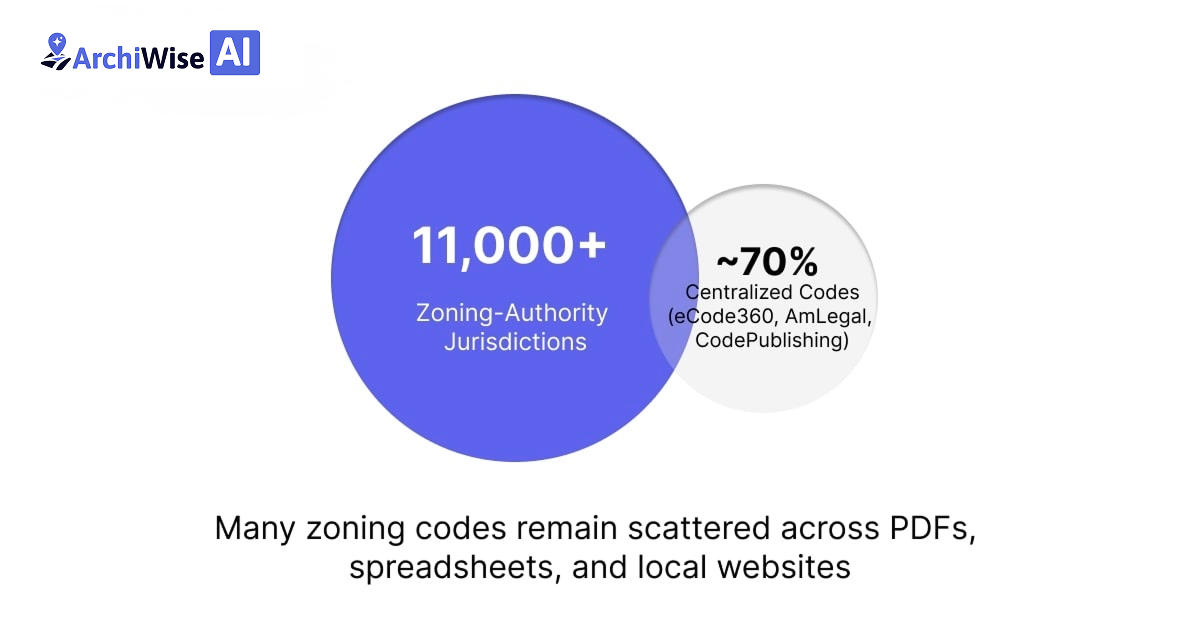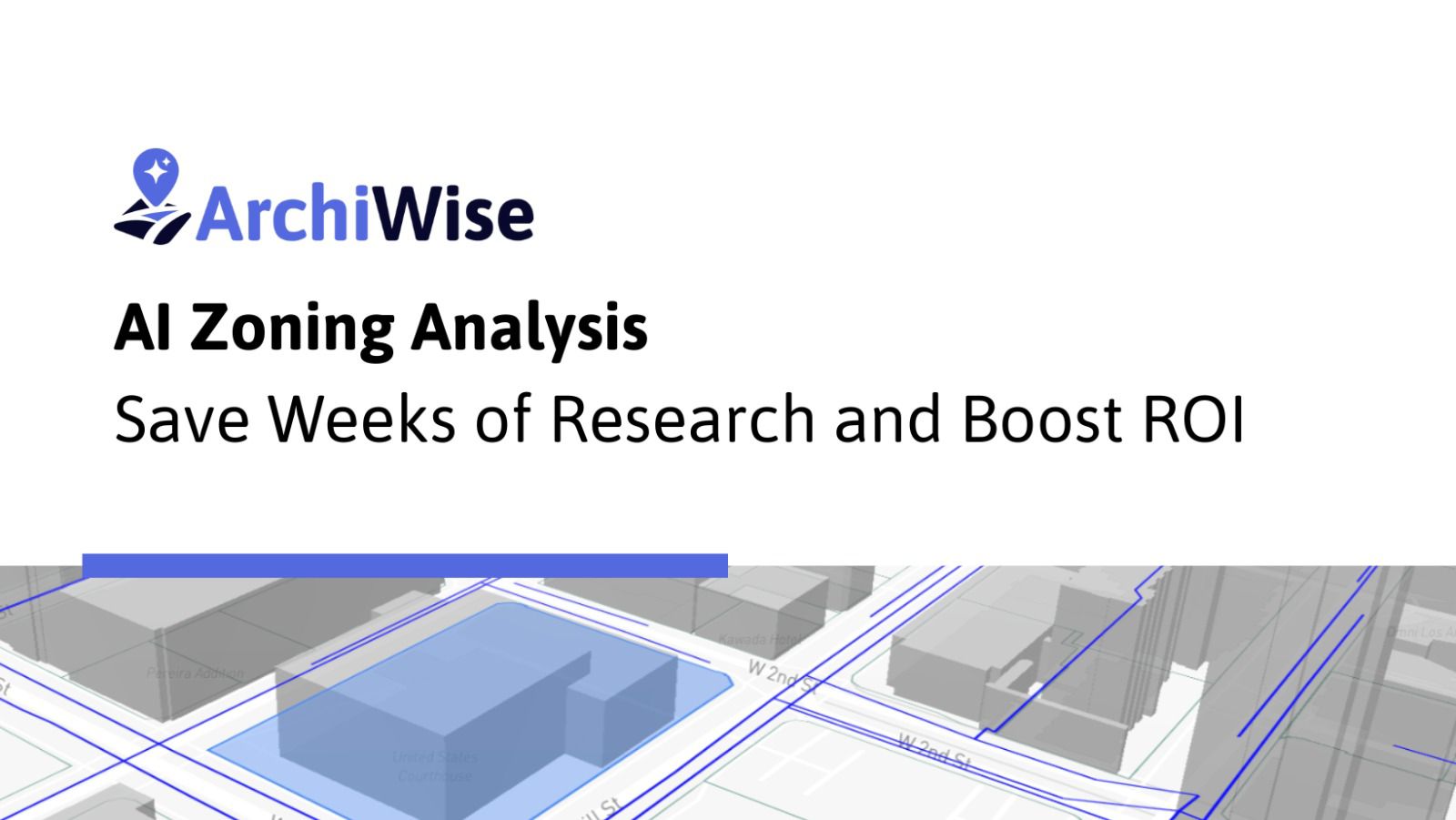Zoning research has been infamously slow and cumbersome, delaying progress and holding projects back for far too long. AI zoning analysis eliminates that time-consuming process and reduces errors to minutes for faster approvals and improved ROI.
Introduction
Did you know that zoning and entitlement reviews account for nearly half of all project delays—stalling developments long before a shovel hits the ground? For decades, zoning analysis has been a major bottleneck to real estate development. Reviewing thousands of municipal codes, analyzing zoning maps, overlays, and area plans, and conducting other compliance checks can stall projects for weeks—sometimes months. These delays don’t just slow construction; they also drive up holding costs and cut into projected revenue
Now we have AI zoning analysis. Using machine learning and natural language processing, AI zoning analysis can combine weeks of work into minutes of actionable conclusions. AI zoning analysis provides information to developers and architects on buildable sites more efficiently, reduces compliance risk, and improves ROI-based decision-making.
We will discuss:
-
Why zoning research delays development
-
How AI zoning analysis increases speed
-
Actionable steps to implementation
-
How to think about AI zoning analysis from the perspective of ROI
-
Key developer, architect, and planner benefits
Why Traditional Zoning Research Delays Development
Zoning code research in the U.S. is disjointed and inefficient—slowing the planning process before design begins.
Across approximately 11,000 jurisdictions with independent zoning, regulations are in different formats and sources. While around 70% of municipal codes are available through centralized databases as eCode360, AmLegal, and CodePublishing, the rest are buried in city websites, PDF files, and area or overlay plans.
This results in planners, architects, and developers spending hours checking various sources, making the simple job of looking up the code a costly and time-consuming one.

How Manual Zoning Research Delays AI Zoning Analysis
Manually researching zoning remains one of the biggest bottlenecks in development. Even when parcels share the same zoning code, GIS professionals must still review, convert, and approve them. City staff rely on phone calls and emails to exchange information, which adds further delays. When codes are misunderstood, projects face additional rounds of edits and approvals—further pushing out timelines and raising costs.
- Many parcels may share the same zoning designation, but each still requires manual review by GIS and planning professionals, since local overlays or area plans can change how the code applies in context.
- City staff continue to handle back-and-forth communication by phone, email, and in-person reviews.
- Any misinterpretation of codes results in additional edits and reviews.
Altogether, these manual processes can extend pre-development timelines, driving up expenses and delaying approvals. Without AI zoning analysis to streamline reviews, projects remain stuck in slow, outdated workflows.
Risks of Delays in Zoning Research and Compliance
Zoning research not only consumes time - it’s also a significant compliance risk. In many cities around the world, the intended project often goes through several passes of review and re-work before) the requests for approvals are met. Each resubmission adds weeks to the predevelopment schedule and costs more, displacing start dates of construction.
Incorrect submissions caused by incomplete data or misinterpretation of zoning regulations easily lead to refusals of the required permits, costs to redesign, and longer periods of hold.
In California,
Smaller projects → typically need 30 days of review
Larger projects or more complex projects → typically go through a cycle of 60 days or more
Expedited reviews may also lead to documents and submissions being returned for corrections as per sfbos.org. This not only hinders the timing of approvals but also discourages developers from exploring markets with complex zoning requirements. This challenge highlights a great opportunity to apply AI zoning analysis to reduce the need for multiple corrections by minimizing manual interpretation during compliance reviews—turning regulatory complexity into a competitive advantage.
How AI Zoning Analysis Automates Research
Artificial intelligence is transforming zoning research by eliminating the burdensome, manual processes that once delayed development. Instead of spending weeks reviewing municipal codes and maps, AI zoning analysis can quickly present zoning designations, setbacks, and development restrictions.
- Scan through hundreds of zoning codes in seconds
- Find zoning classifications, setbacks, permitted land uses, key development controls, allowances, etc.
- Compare parcels for ROI, restrictions, and access
Explore AI Property Investigator
Conclusion:
By automating zoning research, Zoning AI allows developers and planners to make faster, data-driven decisions. The result is reduced compliance risk, faster pre-development pace, and a clearer path to higher ROI.
How AI Zoning Analysis Creates Better ROI
It’s not only about time—it’s about profitability. Research and revision time will not only be reduced, but the use of AI zoning analysis is more beneficial in terms of ROI.
ROI by Using AI Zoning Analysis
- Accelerated Approvals — Automated zoning checks reduce review time from weeks to hours, speeding up entitlement and planning workflows.
- Reduced Compliance Risks — Instant ordinance cross-referencing reduces human error and overlooked limitations.
- Maximized Land Use — AI zoning analysis identifies parcels with stronger density potential
- Smarter Site Selection — Analyze ROI, infrastructure, and restrictions in advance
- Reduced Time to Market — Projects begin to generate revenue sooner
Beyond these savings, AI zoning analysis also reduces risk exposure. Developers who adopt AI gain clarity on compliance before submitting plans, lowering the chance of rejected permits. Investors benefit too, since projects can be evaluated on ROI scenarios before committing capital.
![]()
The Process: Journey with AI Zoning Analysis
ArchiWise transforms zoning questions at the parcel-level into shareable, citable answers in minutes. Using AI Zoning Expert, find a parcel by address or APN (Assessor’s Parcel Number), and get instant clarity on municipal code translated to structured rules (allowed uses, setbacks, height/FAR/coverage, parking and permit triggers), interactive map-based context, and generate share-ready reports to move teams through “What’s allowed here?” to clarity quickly.
To add depth of context and collaboration to the zoning output, include modules such as Property Researcher, Site Selection, and Visualizer.
Step by step
-
Find the Parcel - (AI Zoning Expert) Search by address or APN, or click directly on the map for instant parcel intelligence. Use the AI chat to generate quick follow-up questions and summaries.
-
AI Extracts the Rules - ArchiWise transforms zoning text into structured citable rules, allowed uses, setbacks, height/FAR/ coverage, parking, and permit triggers, so you can see what’s by right vs. conditional.
-
Overlay Context and Constraints - On an interactive map, view base zoning districts, overlays and constraints, use AI chat to ask questions about edge cases, and generate parcel summaries on the fly.
-
Generate a Zoning Report (One Click) - Export a clean, shareable report complete with the extracted standards and formats. This is done for internal review and planning conversations.
Optional modules
-
Property Researcher - add environmental, infrastructure, ownership, and feasibility context.
-
Site Selection – employ zoning-aware filters for parcels when searching through other options for your development team.
-
Visualizer – turn the rules from zoning reports into quick massings/blueprints to communicate intent.
Why this Matters
ArchiWise condenses zoning from a multi-tab, manual slog into a repeatable, citable workflow. Teams transmute from “Can we build?” to go/no-go confidence in minutes, and they can scale the same process across portfolios. Work with AI Zoning Expert first, add on the additional modules as needed, and select a plan of choice when you are ready. Start your free trial or book a demo.
Key Takeaways from AI Zoning Analysis
AI zoning analysis is changing the way developers, planners, and architects undertake projects. Here are the primary benefits it offers:
-
AI zoning review accelerates weeks of preparation into minutes
-
Automated compliance minimizes unnecessary and costly redesign work
-
Integrated data + visualization = faster and more accurate decisions
-
AI zoning analysis provides developers, planners, and architects an extremely valuable ROI
Conclusion:
In today’s real estate landscape, delays, compliance risks, and manual inefficiencies can make or break a project. AI zoning analysis removes those barriers by speeding up research, reducing failures, and providing actionable insights instantly. That’s exactly where ArchiWise comes in. With interactive zoning maps, automated compliance verification, and ROI-driven feasibility reports, ArchiWise helps developers, planners, and architects move projects forward with certainty.
Here’s the bottom line: AI zoning analysis is no longer an option; it’s a competitive edge. Start using ArchiWise today and turn months of zoning analysis into minutes.
AI Zoning Analysis FAQ
Q: Will AI zoning analysis replace human planners?
A: No. AI zoning analysis enhances the work of planners—it automates data gathering and compliance checks so professionals can focus on design, strategy, and decision-making.
Q2: How accurate is AI zoning analysis?
A: AI zoning analysis is about 99% accurate when aggregating thousands of ordinances and flagging anything ambiguous for human review.
Q3: What cities have the most complicated zoning?
A: Los Angeles, New York City, and Chicago have the most fragmented zoning codes and ordinances.
Q4: How long do AI zoning analysis reports take?
A: Reports take just minutes, compared to weeks of manual research.
